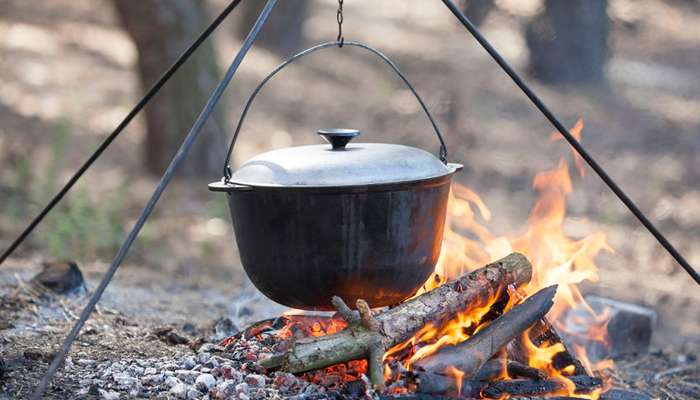
The Dutch oven we all know today has seen some changes over the past 300 years. Some of the changes include legs to keep the pot off the coals and a flanged flat lid to hold hot coals on top of the oven. The ability to provide heat on top and heat from below allows for uniform cooking, so the Dutch oven can actually serve as an oven.
You can boil, bake, stew, fry, and roast in a Dutch oven, which makes them extremely versatile. If you have a Dutch oven, you can cook anything anywhere as long as you have the ability to create a fire.
For off-grid cooking, you would want an oven with a well fitting flat lid with a flange so you can pile hot coals on top. You probably want one with legs, and a wire (bail) handle, one that will not get hot, so it can be hung over a fire and moved easily. Some of the newer models have formed handles on the side of the pot and some are even enamel-coated cast iron with a lid that will not allow you to put coals on top. Real cast iron in all its glory is better suited for camp life, and once well seasoned you will never have a problem with food sticking.
Curing and Cleaning
If the cast iron is rusted, use a fine grain sandpaper to remove the rust and expose the metal. Once the rust is removed wash with hot soapy water and dry well. Washing with soap and water removes the wax coating on new pans and removes rust and other debris on older pans that you are trying to restore.
Some do not believe in using water let alone soap on any cast iron. However, if you try to clean your cast iron by heating it to reduce the food debris to dust or char, you may be doing more harm than good. The food build up will make other food stick because it essentially covers up the cast’s surface which is cured.
Wipe excess food out with a dry cloth or paper towel, and hand wash with water using a stiff nylon brush or use coarse salt if needed. You can even dry it over low heat and then apply the oil while still warm. Do not let it soak in the sink.
Note:Once cured the oil used for curing is no longer oil as we know, and this is why a well-maintained cast iron pan will not be affected by a little soap occasionally, but we do not recommend you use soap as part of your regular cleaning, however.
The oil changes after repeated heating’s and it actually forms a bond with the metal and the more you cook and apply oil after each, the better the bonding becomes. The non-stick properties happen over time. It is created by the changes that the oil and the metal go through, which creates the smooth, almost Teflon-like surface.
Once dry wipe a light coating of oil or lard on all surfaces to include legs and lid, and over time you will see a dark rich color emerge, which means your oven is well cured.
Scraping food out with metal utensils will scratch the metal and this will cause food to stick next time because you could strip the pans’ seasoning in places. Seasoning or curing creates natural, easy-release properties, and the more you cook, the better it gets.
First, you have to create and then maintain, and even repair the seasoning, and if you do, your cast iron Dutch oven will last your lifetime and for generations after.
Stay with us for the next article for recipes and cooking over an open fire using your cast iron Dutch oven.